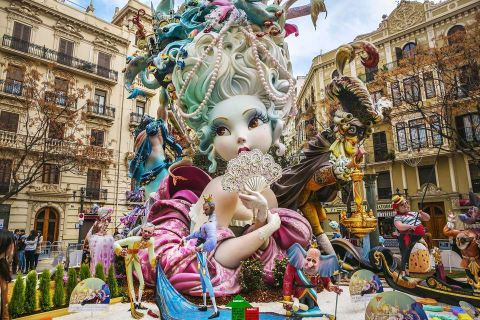Historia

Pequeña historia de las fallas
El origen de la fiesta de las Fallas se remonta a la antigua tradición de los carpinteros de la ciudad, que en vísperas de la fiesta de su patrón San José, quemaban frente a sus talleres, en las calles y plazas públicas, los trastos viejos e inservibles junto con los artilugios de madera que empleaban para elevar los candiles que les iluminaban mientras trabajaban en los meses de invierno. Por ese motivo el día de la cremá (momento en el que arden los monumentos falleros) siempre coincide con el día 19, Festividad de San José.
En el siglo XVIII, XIX y principios del XX, las Fallas eran, desde simples montones de maderos, a trastos entregados por los vecinos a los niños que los pedian "una estoreta velleta per a la falla de Sant Josep, el tio Pep" como se canta actualmente en el incomparable El fallero.
En 2016 Las Fallas fueron declaradas Patrimonio inmaterial de la humanidad por la Unesco.

1916
![]() The origin of the Fallas festival dates back to the ancient tradition of the city's carpenters, who on the eve of the festival of their patron saint, Saint Joseph, burned old junk in front of their workshops, in the streets and public squares useless along with the wooden contraptions they used to raise the lamps that illuminated them while they worked in the winter months. For this reason, the day of the "cremá" (the moment in which the Fallas monuments burn) always coincides with the 19th, the Festival of San José.
The origin of the Fallas festival dates back to the ancient tradition of the city's carpenters, who on the eve of the festival of their patron saint, Saint Joseph, burned old junk in front of their workshops, in the streets and public squares useless along with the wooden contraptions they used to raise the lamps that illuminated them while they worked in the winter months. For this reason, the day of the "cremá" (the moment in which the Fallas monuments burn) always coincides with the 19th, the Festival of San José.
In the 18th, 19th and early 20th centuries, the Fallas were, from simple piles of wood, to junk given by neighbors to children who asked for "a little velleta for the Falla of Sant Josep, Uncle Pep" as it is currently sung in the incomparable El fallero.
In 2016 Las Fallas were declared Intangible Heritage of Humanity by UNESCO.